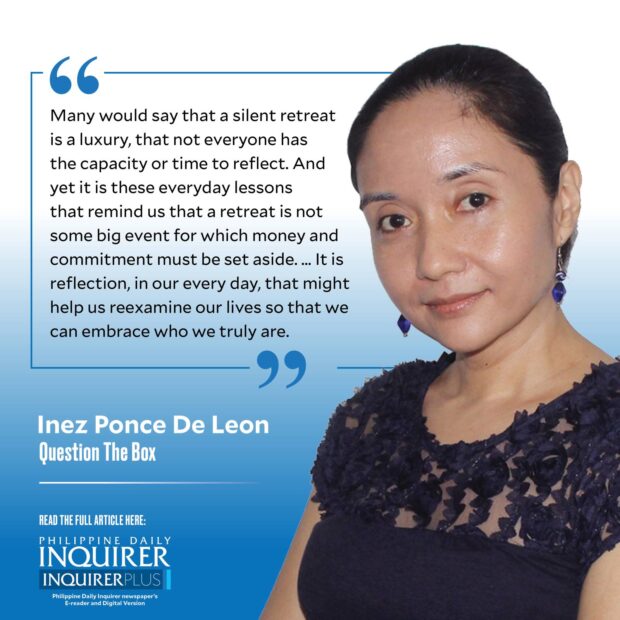Prayers, paper, and paths
 I am in Mirador, the Jesuit retreat house in Baguio, for another silent retreat.
I am in Mirador, the Jesuit retreat house in Baguio, for another silent retreat.
Mirador sits amongst the clouds. Around it are terraces, carved into the mountain, with rock and limestone paths that lead to memorials, images of the saints, Ifugao model houses, and benches looking down into the most picturesque views of Baguio. In the dry season, these views blush with the sunrise, are drowned in the gold of the sunset, sparkle with flowers at noon.
In the wet season, as in today, Baguio is shrouded almost completely by mist, and the retreat house is pelted with near-solid rain that thunders with opposing winds. In the thick fog, there is an illusion of isolation, of a place so far removed from the world, that the more time one spends in it, the less aware they are of the hustle and bustle, the burbles and troubles, the wins and sins of the cities below.
A silent retreat is exactly that: a calculated withdrawal from the corporal, to spend time in one’s inner self. The Ignatian silent retreat also has a strong scriptural aspect that ties neatly into the practical: God is in all things, so to find Him, we must also weave prayer into our daily existence.
By that same token, then, simply walking around the mountain is prayer. It is an activity of being in the moment, looking down at one’s path rather than its origin and destination, meditating on one’s role, dreams, regrets, and abilities as a tangled, imperfect, loved human.
At this retreat, my spiritual director is Fr. Munching de Guzman SJ, a homilist who can relate everything in scripture to the life of the everyday. Today, we somehow arrived at a conversation on art.
Father Munching is a self-trained watercolor artist: He showed me photographs of his paintings, which included a cubist rendering of Jesus, a graceful sketch of the Virgin Mary, a tray of grapes blinking back the glare of unseen light, a school of blue fish swimming in a dim ocean. His work, he said, was “prayers wrapped in painting.”
It was a manifestation of a very Jesuit brand of spirituality, of enclosing prayers in simple things, of using one’s imagination to speak the words that human language cannot articulate. Father Munching saw symbols in everything: God in candlelight, utterances of love in lips shaped like hearts, the faces of happiness in the poor even amid darkness.
He wanted people to hang up the paintings in their houses to remind them of their spiritual lives. His efforts have since borne fruit: He once auctioned his art to send aid to storm-ravaged Cebu. Those who had bought the paintings told him that his work had spoken to them, telling them to choose to be content with riches both real and abstract, to hold their families close, to be a light in the world.
The lessons ran deeper, as he spoke of the act of painting. He works with only three colors and mixes them, rather than rely on a palette with precise shades and hues. The mixing, he says, is meticulous: He has to make multiple strokes of brush against pigment, multiple attempts of brush upon paper, all to achieve the color that he wants.
After he paints the first layer, he has to wait for his work to dry before adding new colors. He was, admittedly, not patient the first time, and used a hair dryer to speed up the process. The paper warped; the colors faded and changed. There was no other option but to wait, to achieve the brilliant textures, the precise shading, the right angles that allowed light to fight against shadow.
Every sheet he used was expensive, so every time he faced a blank sheet, he would always ask God for assistance. Many of his paintings, he said, were first attempts. They were the products of prayerful waiting.
In painting, as in life: patience.
Many would say that a silent retreat is a luxury, that not everyone has the capacity or time to reflect. And yet it is these everyday lessons that remind us that a retreat is not some big event for which money and commitment must be set aside. It is as simple as walking through new roads and looking inward; filling a blank canvas with images; or this, the act of writing.
It is reflection, in our every day, that might help us reexamine our lives so that we can embrace who we truly are. Perhaps in a brief departure from the world, we might come to understand our true selves.
iponcedeleon@ateneo.edu




















